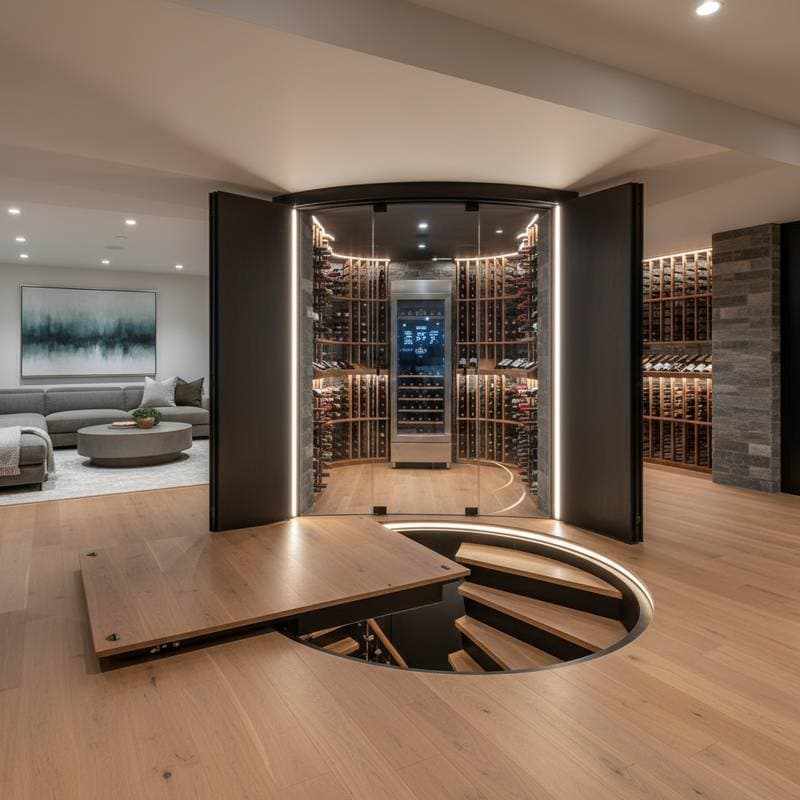Hidden Wine Cellars: A 15% Value Boost for Homes in 2025
Homeowners increasingly incorporate hidden wine cellars to elevate property worth. These installations transform underutilized areas, such as basements or spaces beneath staircases, into controlled environments ideal for wine storage. A thoughtfully executed cellar not only safeguards collections but also contributes approximately 15 percent to resale value, according to real estate trends.
This addition appeals to wine enthusiasts and those seeking distinctive home features. Consider it during broader renovations, like basement updates, where sealing and insulating an existing space proves straightforward. The result combines aesthetic refinement with practical utility, making the home stand out in competitive markets.
Weighing the Advantages and Drawbacks
Hidden wine cellars offer clear benefits alongside notable challenges. Understanding both helps determine if this upgrade aligns with your goals.
Key Advantages
- Enhances resale potential through a premium, integrated feature.
- Maintains optimal wine conditions with consistent temperature and humidity levels.
- Maximizes space by repurposing areas that might otherwise remain idle.
- Provides a subtle touch of luxury without overt display.
- Integrates smoothly into various architectural styles.
Potential Drawbacks
- Involves significant initial expenses and continuous energy consumption.
- Demands exacting control over temperature and moisture to function effectively.
- Often requires modifications to meet structural or regulatory standards.
- Limits adaptability after construction due to fixed installations.
- Poses risks of issues like condensation or mold without proper sealing.
Choosing Between DIY and Professional Installation
Attempting a hidden wine cellar as a DIY endeavor demands advanced skills and resources. Professional involvement typically yields superior results, especially for complex setups.
DIY Considerations
- Difficulty Level: Advanced, suitable only for experienced builders.
- Timeline: Expect two to four weeks for compact projects; larger conversions may span several months.
- Essential Tools: Gather insulation materials, vapor barriers, electrical kits, and cooling unit parts.
- Primary Risks: Potential for structural compromise, water damage, or electrical malfunctions.
Opt for professional services in scenarios involving excavation, structural reinforcements, or advanced systems like cooling units and vapor barriers. Experts also handle permits for electrical or plumbing integrations. A certified builder guarantees precise climate management, airtight seals, and adherence to local codes, safeguarding your investment and collection.
Ensuring Longevity Through Maintenance
Regular upkeep preserves the cellar's performance and extends its service life. Focus on routine checks to address issues early.
Monitor temperature and humidity levels each month, targeting 55 degrees Fahrenheit and 60 percent relative humidity for ideal wine storage. Perform deep cleans of vents and filters biannually to prevent dust buildup. Annually inspect door seals and lighting fixtures for wear. Cooling systems generally endure eight to 15 years under diligent care, while racks and interior finishes can persist for decades in a moisture-free setting. Reputable builders provide warranties ranging from one to five years on mechanical components.
Adapting to Regional Influences
Local conditions shape the design, construction, and expenses of a wine cellar. Tailor your approach to environmental and regulatory realities.
In humid regions near coasts, prioritize robust vapor barriers and dehumidification equipment to combat excess moisture. Arid areas benefit from enhanced insulation to retain necessary humidity. Colder climates necessitate features like heated air intakes to shield cooling elements from freezing.
Municipal codes differ significantly; some locales mandate permits for electrical upgrades or ventilation in enclosed spaces. Urban hotspots such as Los Angeles, New York, and Miami amplify returns on luxury additions due to high demand. Factor in elevated labor costs in crowded cities, where site access complicates installations.
Prioritizing Safety in Design and Build
Safety forms the foundation of any wine cellar project. Adhere to protocols that protect inhabitants, the structure, and stored items.
Install dedicated electrical circuits for cooling units and avoid routing wires near potential condensation paths. Implement effective drainage systems or vapor management to eliminate mold hazards. For projects requiring excavation, conduct a thorough foundation assessment prior to any digging. Direct cooling exhaust away from habitable areas to maintain air quality. Use hardware rated for heavy loads on glass doors or mechanical lifts.
Secure necessary permits for electrical, HVAC, or plumbing alterations. Unauthorized constructions can diminish property value and complicate insurance claims.
Planning Your Wine Cellar Project
Start by assessing suitable spaces in your home, measuring dimensions and evaluating accessibility. Determine if you prefer a concealed setup or one with subtle display elements to suit your needs.
Solicit quotes from at least three licensed specialists, inquiring about insulation techniques, cooling system brands, and warranty details. For value-driven projects, emphasize timeless designs and resilient materials over ornate details. Ensure the cellar remains user-friendly for maintenance and inventory access.
Personalize with custom lighting and racking configurations to accommodate your wine preferences. This upgrade transcends mere storage; it delivers enduring enhancement, blending preservation with refined appeal. Professional execution secures lasting benefits, from wine protection to heightened market desirability.










